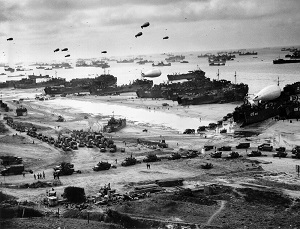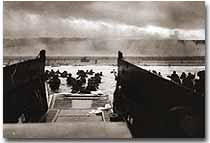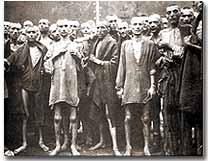51c. D-Day and the German Surrender

Hitler's refusal to surrender to the Allies led to "Operation Overlord" on June 6, 1944. British, Canadian, and American forces managed to take key points on the coast of Nazi-occupied France, signaling a beginning to the end of war in Europe.
The time had finally come. British and American troops had liberated North Africa and pressed on into Italy. Soviet troops had turned the tide at Stalingrad and were slowly reclaiming their territory. The English Channel was virtually free of Nazi submarines, and American and British planes were bombing German industrial centers around the clock.
Still, Hitler refused to surrender and hid behind his Atlantic Wall. Since the outbreak of war, Stalin was demanding an all-out effort to liberate France from German occupation. An invasion force greater than any in the history of the world was slowly amassing in southern Britain toward that end.

D-Day troops wade into the waist-deep water and onto the shore to face the enemy in battle.
A great game of espionage soon unfolded. If the Germans could discover when and where the attack would occur, they could simply concentrate all their efforts in one area, and the operation would be doomed to failure. The Allies staged phony exercises meant to confuse German intelligence. Two-dimensional dummy tanks were arranged to distract air surveillance. There was considerable reason to believe the attack would come at Calais, where the English Channel is narrowest. In actuality, Operation Overlord was aiming for the Normandy Peninsula on the morning of June 4, 1944.
Foul weather postponed the attack for two days. Just after midnight on June 6, three airborne divisions parachuted behind enemy lines to disrupt paths of communications. As the German lookout sentries scanned the English Channel at daybreak, they saw the largest armada ever assembled in history heading toward the French shore. There were five points of attack. Gold and Sword Beaches were taken by the British, and Juno Beach was captured by Canadian forces. The American task was to capture Utah and Omaha Beaches. The troops at Omaha Beach met fierce resistance and suffered heavy casualties. Still, by nightfall a beachhead had been established. Eventually, German troops retreated.
After D-Day, the days of the German resistance were numbered. Paris was liberated in August 1944 as the Allies pushed slowly eastward. Meanwhile, the Soviet Union was moving into German territory as well. Hitler, at the Battle of the Bulge, launched a final unsuccessful counteroffensive in December 1944. Soon the Americans, British, and Free French found themselves racing the Soviets to Berlin.

Following the defeat of the Nazi regime, the full extent of the Holocaust was at last revealed. These survivors of the Ebensee concentration camp were among the 250,000 liberated by Allied troops. Approximately 12,000,000 people were killed between 1933-45.
Along the way they encountered the depths of Nazi horrors when they discovered concentration camps. American soldiers saw humans that looked more like skeletons, gas chambers, crematoriums, and countless victims. Although American government officials were aware of atrocities against Jews, the sheer horror of the Holocaust of 12 million Jews, homosexuals, and anyone else Hitler had deemed deviant was unknown to its fullest extent.
When the Allies entered Berlin, they discovered that the mastermind of all the destruction — Adolf Hitler — had already died by his own hand. With little left to sustain any sort of resistance, the Germans surrendered on May 8, 1945, hereafter known as V-E (Victory in Europe) Day.






